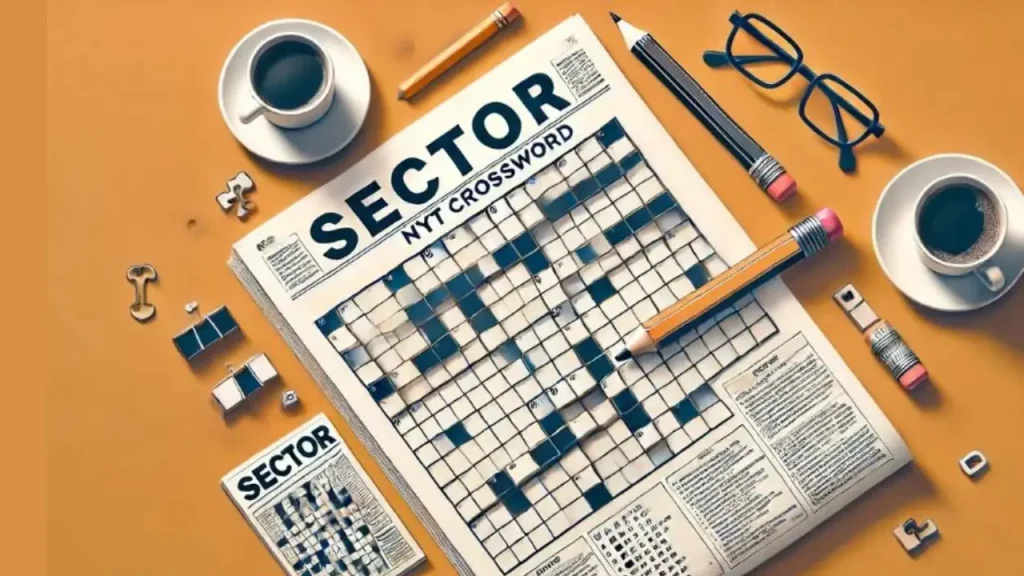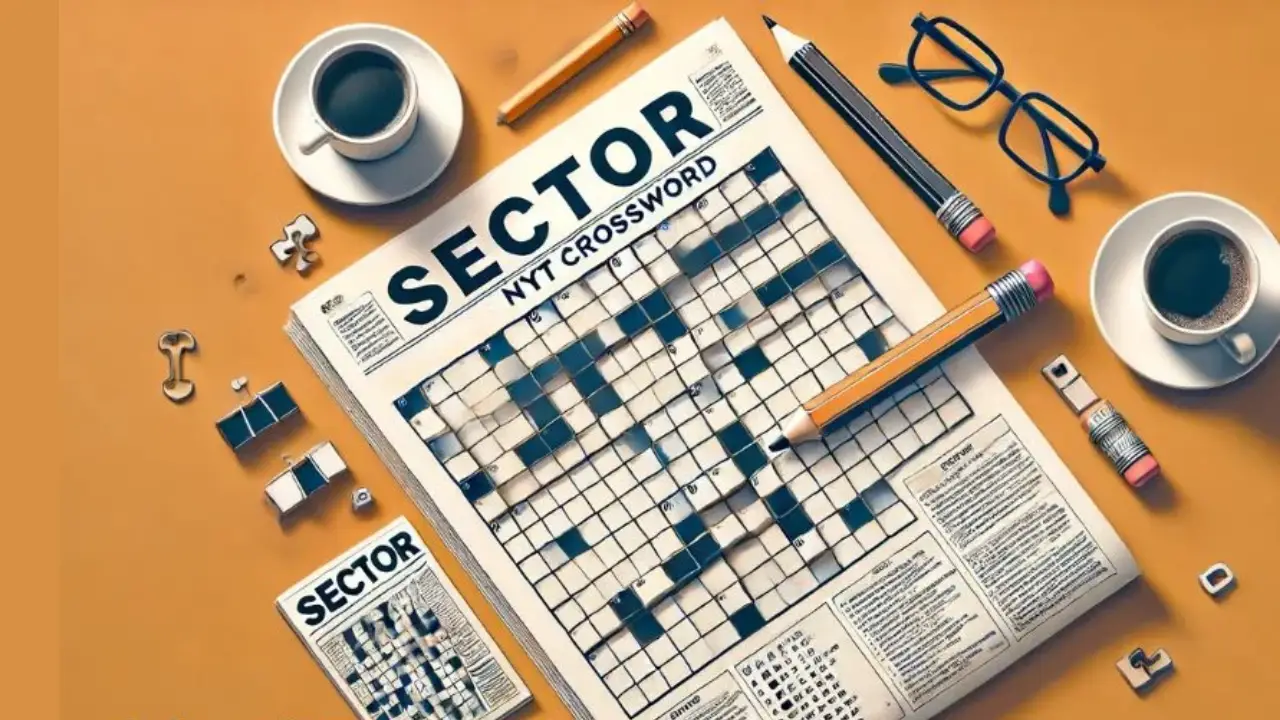Sector NYT Crossword

Sector NYT Crossword puzzles are a beloved pastime for many, offering a mix of challenge and entertainment.
They serve as excellent tools for improving language skills and keeping the mind sharp. Among the many crossword puzzles available, The New York Times crossword puzzle stands out as a cultural icon.
| Fact | Detail |
| Definition | “Sector” refers to a specific area or section in crosswords. |
| Difficulty Levels | Easy (Monday) to hard (Sunday) |
| Famous Creators | Will Shortz, Merl Reagle |
| Cognitive Benefits | Enhances vocabulary, memory, problem-solving skills |
| Mental Health Benefits | Provides stress relief, relaxation |
| Beginner Tips | Start with easy puzzles, use online tools |
| Advanced Techniques | Pattern recognition, lateral thinking |
| Educational Value | Improves critical thinking, vocabulary |
| Recreational Value | Relaxing and rewarding pastime |
| Online Resources | Crossword dictionaries, NYT Crossword app |
| Community | Forums on websites like Reddit |
| Themes | Wide variety, including culture, wordplay, and specific sectors |
| Sense of Achievement | High upon completing difficult puzzles |
| Encouragement | Persistence and practice improve skills and enjoyment |
Overview of Sector NYT Crossword Puzzles and Their Benefits
- Crossword puzzles are word games where players fill in a grid based on clues provided.
- These puzzles are beneficial for enhancing vocabulary, improving memory, and stimulating cognitive functions.
- They also provide a sense of accomplishment upon completion, making them a rewarding activity.
Introduction to The sector NYT Crossword Puzzle
The New York Times crossword puzzle is renowned for its quality and complexity.
It has been a staple of the newspaper since 1942, drawing in millions of solvers worldwide. The puzzle is known for its clever clues, diverse themes, and varying difficulty levels throughout the week.
Importance of Solving Crosswords for Cognitive Development and Relaxation Solving crossword puzzles regularly can lead to significant cognitive benefits, such as:
- Improving problem-solving skills
- Enhancing memory
- Boosting mental agility
Additionally, crosswords offer a form of relaxation, providing a break from daily stress and allowing the mind to unwind.
The sector NYT Crossword Puzzle
The New York Times crossword puzzle has a rich history, having first appeared in the newspaper in 1942.
It quickly became a beloved feature, known for its high standards and engaging challenges. The puzzle has since become a cultural phenomenon, often referenced in movies, books, and popular culture.
Popularity and Its Role in American Culture
The sector NYT Crossword puzzle plays a significant role in American culture. It is a daily ritual for many readers, who eagerly await the challenge each morning.
The puzzle’s influence extends beyond its solvers, inspiring crossword tournaments and dedicated fan communities.
Notable Puzzle Creators
Notable figures like Will Shortz and Merl Reagle have shaped The sector nyt Crossword puzzle. Will Shortz, the current puzzle editor, is celebrated for his innovative and challenging puzzles.
Merl Reagle, a legendary crossword constructor, is remembered for his witty and creative clues.
Cognitive Benefits of Crossword Puzzles
- Enhancing Vocabulary and Memory: Crossword puzzles are excellent for enhancing vocabulary. Solvers are exposed to new words and phrases, which helps expand their language skills. Additionally, the need to recall words and clues improves memory and strengthens mental recall abilities.
- Improving Problem-Solving Skills: Crossword puzzles require solvers to think critically and make connections between clues and answers. This process enhances problem-solving skills and encourages logical thinking. The ability to decipher complex clues and find solutions translates to better analytical skills in everyday life.
Mental Health Benefits
- Solving crossword puzzles can be a form of stress relief. Engaging in this mentally stimulating activity provides a break from daily worries and promotes relaxation.
- Studies have shown that solving puzzles can help reduce anxiety and improve overall mental well-being.
Difficulty Levels
The New York Times crossword puzzle increases in difficulty as the week progresses:
- Monday’s puzzles are the easiest, designed for beginners.
- As the week advances, the puzzles become more challenging, culminating in the difficult Saturday puzzle.
- Sunday’s puzzle is larger and themed, but not necessarily harder than the weekdays.
Recommendations for Beginners and Advanced Solvers
- Beginners are encouraged to start with Monday puzzles to build confidence and develop solving skills.
- Advanced solvers can challenge themselves with the more difficult puzzles later in the week.
- This progression helps solvers gradually improve their abilities and tackle more complex puzzles over time.
Tips for Gradually Increasing Puzzle-Solving Skills
- Practice regularly and start with easier puzzles.
- Use online tools and resources to learn new solving techniques and familiarize yourself with common crossword tricks.
- Persistence and patience are key to becoming a proficient solver.
Themes and Clues
- The New York Times crossword puzzle is known for its diverse themes, which range from pop culture references to historical events.
- Each puzzle offers a unique challenge, keeping solvers engaged and entertained.
- The variety of themes ensures that there is always something new and interesting to solve.
Types of Clues
- The puzzle features a wide array of clue types, including wordplay, puns, anagrams, and cultural references.
- These clues require different solving techniques, making the puzzle dynamic and exciting.
- Wordplay and puns add a layer of fun, while cultural references challenge solvers’ knowledge.
The Challenge and Satisfaction of Solving Intricate Clues
- Solving intricate clues can be challenging, but it is also highly satisfying.
- The process of decoding a tricky clue and filling in the correct answer provides a sense of accomplishment.
- This satisfaction keeps solvers motivated and eager to tackle new puzzles.
Sector-Specific Clues
In crossword puzzles, “sector” often refers to a specific area or segment of the puzzle grid.
Clues related to sectors might involve themes or answers confined to a particular part of the puzzle.
Understanding how sectors work can help solvers approach these clues with the right strategy.
Examples of Sector-Specific Clues and Their Solutions
- Examples of sector-specific clues might include phrases like “northwest corner” or “diagonal sector.”
- Solvers need to focus on these specific areas to find the correct answers.
- For instance, if a clue points to the “southwest sector,” all related answers will be found in that part of the grid.
Strategies for Solving Sector-Based Puzzles
- When tackling sector-based puzzles, it is helpful to work on one sector at a time.
- Solvers should look for intersecting clues that provide hints for the sector.
- Breaking down the puzzle into smaller segments makes it more manageable and increases the chances of solving the entire grid.
By understanding the structure and strategies for solving The New York Times crossword puzzle, enthusiasts can enhance their skills and enjoy the numerous benefits that come with this intellectually stimulating activity.
Solving Strategies
- Tips for Beginners: For those new to crossword puzzles, starting with easier puzzles is key. Monday puzzles in The New York Times are the best starting point as they are designed to be the simplest. Using online tools, such as crossword dictionaries and anagram solvers, can also help beginners learn common clues and patterns.
- Techniques for Advanced Solvers: Advanced solvers benefit from recognizing patterns and using lateral thinking. This means looking at clues from different angles and considering multiple meanings of words. Techniques like focusing on the shortest answers first and filling in known answers can provide a foothold in the puzzle.
- Importance of Practice and Patience: Improving puzzle-solving skills takes practice and patience. Regularly solving puzzles helps build familiarity with common clues and word patterns. It’s important to be persistent and not get discouraged by difficult puzzles, as each attempt enhances problem-solving abilities.
Resources for Crossword Enthusiasts
- Online Tools and Apps: There are numerous online tools and apps available to assist crossword enthusiasts.
Crossword dictionaries and anagram solvers can be invaluable for finding tricky answers. Apps like “NYT Crossword” offer daily puzzles and tips, making it easy to practice and improve. - Books on Crossword Strategies and Tips: Books dedicated to crossword strategies offer in-depth tips and tricks for solvers of all levels.
Titles like “Crossword Puzzle Challenges for Dummies” provide useful insights into solving techniques and common puzzle themes. - Online Communities and Forums: Joining online communities and forums can be beneficial for puzzle enthusiasts.
Websites like Reddit have active crossword puzzle forums where solvers share tips, discuss tricky clues, and support each other. Engaging with these communities can enhance the puzzle-solving experience.
Wordplay and Creativity
- The Role of Sophisticated Wordplay in The New York Times Crossword: Sophisticated wordplay is a hallmark of The New York Times crossword puzzle.
This includes puns, anagrams, and double meanings, which add a layer of creativity and challenge.
Such wordplay not only makes the puzzle more engaging but also stimulates cognitive functions. - How Wordplay Enhances the Puzzle-Solving Experience: Wordplay enhances the puzzle-solving experience by making it more fun and intellectually stimulating.
Clever clues that require thinking outside the box provide a sense of delight when solved. This creative aspect keeps solvers coming back for more. - Examples of Clever Clues and Their Solutions: Examples of clever clues include puns like “On the rocks?” for “ICE” or anagram-based clues where the answer is a rearrangement of letters.
Solving these clues provides a sense of satisfaction and highlights the ingenuity involved in puzzle creation.
Educational and Recreational Value
- Crossword Puzzles as a Teaching Tool in Educational Settings: Crossword puzzles can be effective teaching tools in educational settings. They help students enhance their vocabulary, improve spelling, and develop problem-solving skills. Teachers can use subject-specific puzzles to make learning more engaging and interactive.
- Benefits for Language Learning and Cognitive Development: For language learners, crossword puzzles are particularly beneficial.
They expose learners to new vocabulary, idioms, and cultural references, aiding in language acquisition.
The cognitive challenge of solving puzzles also promotes mental flexibility and sharpens critical thinking. - Recreational Value of Solving Crossword Puzzles: Beyond educational benefits, crossword puzzles are an enjoyable recreational activity.
They provide a relaxing way to pass the time, offering both challenge and entertainment. Solving puzzles with friends or family can also be a fun social activity, fostering connection and collaboration.
Themed Crosswords
- Variety of Themes in The New York Times Crossword Puzzle: The New York Times crossword puzzle features a wide variety of themes, ranging from pop culture and history to wordplay and specific sectors. Each puzzle’s theme adds a unique twist, requiring solvers to think creatively and adapt their strategies.
- How Themes Add Depth and Interest to the Puzzle-Solving Experience: Themes add depth and interest by creating a unifying thread throughout the puzzle. They often include clever wordplay or cultural references, making the puzzle more engaging. For instance, a puzzle with a theme based on movies might have answers related to famous film titles or actors.
- Examples of Memorable Themed Crosswords: Memorable themed crosswords include those that celebrate anniversaries, holidays, or significant cultural events. For example, a puzzle themed around the Oscars might feature answers like “BESTPICTURE” or “RED CARPET.” Such themes make solving the puzzle a more immersive experience.
Conclusion
The New York Times crossword puzzle is more than just a game; it’s a cultural icon that challenges and entertains solvers of all skill levels.
Whether you’re a beginner looking to improve your language skills or an advanced solver seeking a mental workout, The New York Times crossword offers something for everyone.
With its cognitive and mental health benefits, educational value, and sheer enjoyment, it’s no wonder this puzzle has stood the test of time.
FAQs about “Sector NYT Crossword”
1. What does “Sector NYT Crossword” refer to in crossword puzzles?
- In the context of crosswords, “Sector NYT Crossword” refers to a specific area or section of the puzzle grid within The New York Times crossword puzzle. Clues related to sectors might involve themes or answers confined to particular parts of the puzzle.
2. How can solving the “Sector NYT Crossword” benefit cognitive functions?
- Solving the “Sector NYT Crossword” can enhance cognitive functions by improving vocabulary, memory, and problem-solving skills. Regularly engaging with this puzzle helps boost mental agility and promotes critical thinking.
3. What mental health benefits does the “Sector NYT Crossword” provide?
- The “Sector NYT Crossword” offers stress relief and relaxation, providing a mental break from daily worries. Engaging in this puzzle can help reduce anxiety and improve overall mental well-being.
4. What tips are recommended for beginners tackling the “Sector NYT Crossword”?
- Beginners should start with easier puzzles, like those published on Mondays, to build confidence. Using online tools such as crossword dictionaries can assist in learning patterns and common clues in the “Sector NYT Crossword.”
5. What are the difficulty levels of the “Sector NYT Crossword”?
- The difficulty of the “Sector NYT Crossword” increases as the week progresses. Monday puzzles are the easiest, while Saturday’s puzzles are the most challenging. Sunday’s puzzle is larger and themed, offering a different type of challenge.
6. How do themed puzzles in the “Sector NYT Crossword” enhance the solving experience?
- Themed puzzles in the “Sector NYT Crossword” add depth and interest by creating a unifying thread throughout the puzzle. Themes often include clever wordplay or cultural references, making the solving experience more engaging and enjoyable.
7. Who are some notable creators of the “Sector NYT Crossword”?
- Notable creators of the “Sector NYT Crossword” include Will Shortz, the current editor, known for his innovative and challenging puzzles, and Merl Reagle, a legendary crossword constructor recognized for his witty and creative clues.
8. Can the “Sector NYT Crossword” be used as an educational tool?
- Yes, the “Sector NYT Crossword” can be an effective educational tool, helping students enhance their vocabulary, improve spelling, and develop problem-solving skills. It makes learning more interactive and fun.
9. What resources are available for enthusiasts of the “Sector NYT Crossword”?
- Enthusiasts of the “Sector NYT Crossword” can benefit from online tools like crossword dictionaries, the NYT Crossword app, and books on crossword strategies. Online communities and forums also provide support and tips for solving.
10. How does wordplay in the “Sector NYT Crossword” contribute to the puzzle-solving experience? –
Wordplay is a significant aspect of the “Sector NYT Crossword,” adding creativity and challenge. It includes puns, anagrams, and double meanings, which make the puzzle more intellectually stimulating and fun to solve.



No Comment! Be the first one.